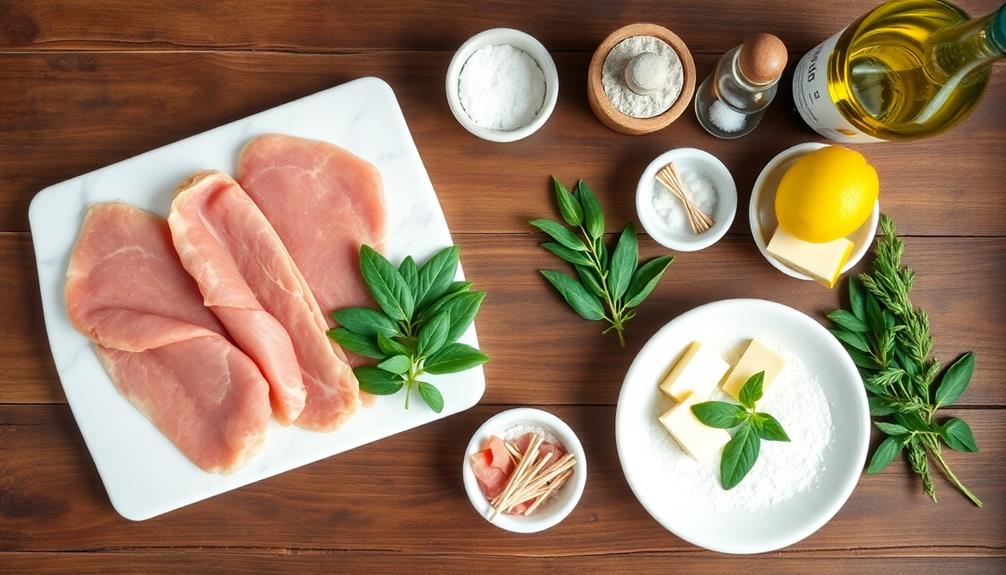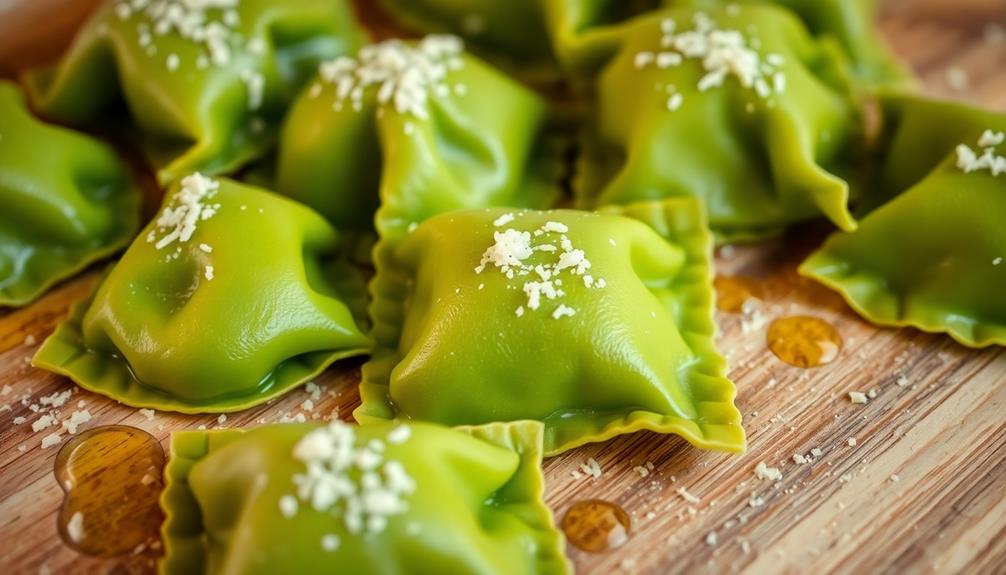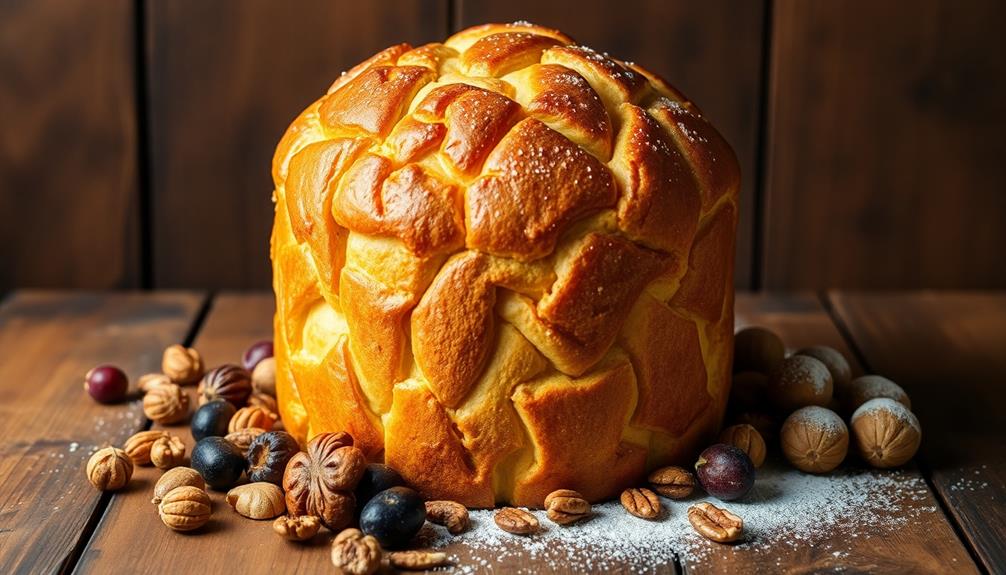Saltimbocca is a mouthwatering Italian dish that'll make your taste buds dance! It's a Roman favorite that's been around since the 1800s. You'll love the combo of thin veal slices, prosciutto, and sage leaves. To make it, you pound the veal, top it with prosciutto and sage, and secure with toothpicks. Then, you cook it in a hot pan with butter and olive oil. Don't forget to add white wine for a yummy sauce! Serve it with veggies or pasta for a perfect meal. There's so much more to discover about this delicious dish that'll have you saying "Mamma mia!"
Key Takeaways
- Saltimbocca is a classic Roman dish featuring thin slices of veal, prosciutto, and sage leaves.
- The dish's name means "jumps in the mouth" in Italian, reflecting its vibrant flavors.
- Traditional preparation involves pounding veal thin, topping with prosciutto and sage, then cooking quickly in a skillet.
- A key step is deglazing the pan with white wine to create a flavorful sauce for the dish.
- While veal is traditional, variations can include chicken or pork as alternatives for the main protein.
History
Saltimbocca's origins can be traced back to Rome, Italy, where it first popped up in the 19th century.
You'll love learning about this tasty dish's history!
The name "saltimbocca" means "jumps in the mouth" in Italian, and it's easy to see why. This delicious meal quickly became a favorite in Roman cuisine. People couldn't get enough of its savory flavors! If you want to try making this classic dish at home, look no further than the best saltimbocca alla romana recipe. With just a few simple ingredients like prosciutto, sage, and tender veal, you can recreate the authentic flavors of Rome right in your own kitchen. Whether you’re cooking for yourself or entertaining guests, this dish is sure to be a crowd-pleaser.
As time went on, saltimbocca spread beyond Rome. It became popular in other parts of Italy and even made its way to other countries.
Here's how it traveled:
- First, it spread to nearby Italian regions
- Then, it reached Switzerland and Austria
- Finally, it became known worldwide
Saltimbocca has changed a bit over the years. Different places have their own special ways of making it.
But the basic idea stays the same:
- Thin slices of veal or chicken
- Topped with prosciutto and sage
- Cooked in butter and white wine
You'll find saltimbocca on menus in fancy restaurants and family kitchens alike.
It's a dish that brings people together and makes any meal feel special!
Recipe
Saltimbocca, meaning "jump in the mouth" in Italian, is a classic Roman dish that perfectly balances the flavors of veal, prosciutto, and sage. This simple yet elegant recipe is a testament to the Italian culinary philosophy of using high-quality ingredients to create extraordinary flavors.
Understanding the importance of budgeting for quality ingredients can elevate your cooking experience and ensure the best results.
Traditionally made with veal, this dish can also be prepared using chicken or pork for a variation. The meat is pounded thin, topped with prosciutto and sage, then quickly cooked in a pan with white wine and butter, resulting in a tender, flavorful main course that truly does "jump in the mouth" with every bite.
- 4 veal cutlets (about 4 oz each), pounded to 1/4 inch thickness
- 4 thin slices of prosciutto
- 8 fresh sage leaves
- 1/4 cup all-purpose flour
- 2 tablespoons olive oil
- 2 tablespoons unsalted butter
- 1/2 cup dry white wine
- Salt and freshly ground black pepper to taste
- Toothpicks for securing
Begin by laying a slice of prosciutto and two sage leaves on each veal cutlet. Secure with toothpicks and season with salt and pepper. Lightly dust each piece with flour, shaking off any excess.
Heat olive oil and butter in a large skillet over medium-high heat. Once hot, add the veal cutlets prosciutto-side down and cook for 3 minutes. Flip and cook for an additional 2 minutes. Remove the veal from the pan and set aside.
Add white wine to the pan, scraping up any browned bits, and let it reduce by half. Pour the sauce over the veal and serve immediately.
For the best results, ensure your veal cutlets are pounded evenly to achieve consistent cooking. If veal is unavailable, chicken breast or pork loin can be substituted.
The key to a perfect saltimbocca is quick cooking to retain moisture and prevent toughness. Be careful not to overcook the prosciutto, as it can become too salty. Lastly, serve the dish immediately to enjoy the crispy texture of the prosciutto and the tender, juicy meat underneath.
Cooking Steps
Let's get cooking!
You'll start by pounding your veal cutlets nice and thin, then seasoning them with salt and pepper.
Next, you'll top each cutlet with a slice of prosciutto and a sage leaf, securing them with toothpicks.
Step 1. Pound Veal Cutlets Thin

Before proceeding with the recipe, you'll need to prepare the veal cutlets. Start by placing a cutlet between two sheets of plastic wrap or wax paper. This step will keep things clean and prevent the meat from sticking to your pounding tool.
Now, it's time to get those arm muscles working! Grab a meat mallet or a rolling pin, and gently pound the veal. You're aiming for an even thickness of about 1/4 inch. Remember, you're not trying to make veal confetti, so use a gentle touch!
As you pound, work from the center outwards in a circular motion. This technique helps spread the meat evenly without tearing it. Keep an eye on the edges, as they tend to thin out faster than the middle.
Here are some tips to make pounding easier:
- Use the flat side of the mallet for even pressure
- Flip the cutlet over halfway through for consistent thinning
- If the meat starts to stick, add more plastic wrap
Once you've achieved the desired thickness, your veal cutlets are ready for the next delicious step in your saltimbocca adventure!
Step 2. Season With Salt and Pepper

With your veal cutlets now perfectly thinned, it's time to add some flavor. Grab your salt and pepper shakers, and let's get seasoning! This step is where the magic begins, bringing out the natural taste of the veal.
Here's how to season your cutlets:
- Lay out the veal pieces on a clean cutting board
- Sprinkle a pinch of salt over each cutlet
- Add a dash of freshly ground black pepper
Don't go overboard with the seasoning. You want to enhance the meat's flavor, not overpower it. Remember, we'll be adding more tasty ingredients later!
As you sprinkle the salt and pepper, imagine the delicious meal you're creating. Your family will love the savory aroma that fills the kitchen. It's like giving your veal a tasty hug!
Once you've seasoned one side, flip the cutlets over and repeat the process. Make sure both sides get equal love. This even seasoning ensures every bite is packed with flavor.
Now your veal is ready for the next exciting step in our Saltimbocca adventure!
Step 3. Top With Prosciutto and Sage

The next crucial step in creating authentic Saltimbocca is topping your seasoned veal cutlets with prosciutto and sage. This combination adds a burst of flavor that'll make your taste buds dance!
Here's how to do it:
- Lay out your seasoned veal cutlets on a clean surface.
- Take thin slices of prosciutto and gently place them on top of each cutlet.
- Make sure the prosciutto covers most of the veal, but don't worry if it's not perfect.
Next, it's time for the sage! Pick fresh sage leaves and place one or two on top of each prosciutto-covered cutlet.
The prosciutto adds a salty, savory taste that complements the veal beautifully. Sage brings an earthy, slightly peppery flavor that ties everything together. It's like a flavor party in your mouth!
Step 4. Secure With Toothpicks

Securing your prosciutto-and-sage-topped veal cutlets is a crucial step in preparing Saltimbocca. Don't worry, it's easier than you might think! Here's how to do it:
- Grab some toothpicks from your kitchen drawer.
- Hold the prosciutto and sage in place on top of the veal.
- Gently push a toothpick through all layers.
- Use 2-3 toothpicks per cutlet for extra security.
Remember, you're creating a delicious package that'll stay together while cooking. It's like wrapping a tasty present for your taste buds!
When you're done, your Saltimbocca should look neat and tidy. The toothpicks will keep everything in place as you cook, ensuring each bite has the perfect blend of flavors.
Here are some tips to make this step even easier:
- Soak the toothpicks in water for 10 minutes before using them.
- Insert toothpicks at an angle for better hold.
- Count how many toothpicks you use, so you don't forget to remove them before serving.
Now that your Saltimbocca is secure, you're ready for the next exciting step in creating this mouthwatering dish!
Step 5. Cook in Butter and Wine

Now that your Saltimbocca is securely assembled, it's time to cook! Get ready for a delicious adventure in your kitchen. Here's how to make your Saltimbocca sizzle:
- Heat up your pan:
- Place a large skillet on medium-high heat
- Add a generous pat of butter (about 2 tablespoons)
- Let it melt and start to bubble
- Cook the Saltimbocca:
- Gently place your prepared Saltimbocca in the hot pan
- Cook for 3-4 minutes on each side until golden brown
- The prosciutto should become crispy and fragrant
- Add the wine:
- Pour in about 1/4 cup of white wine
- Let it sizzle and reduce for 2-3 minutes
- The wine will create a delicious sauce
- Finish and serve:
- Remove the toothpicks carefully
- Transfer the Saltimbocca to plates
- Spoon the buttery wine sauce over the top
Your kitchen will smell amazing, and your family will be eager to dig in!
Serve your Saltimbocca right away with some roasted vegetables or a fresh salad. Enjoy your homemade Italian feast!
Final Thoughts
Wrapping up our exploration of saltimbocca, we've learned about this classic Italian dish's delightful combination of flavors and textures.
You've discovered how to create this mouth-watering meal that's sure to impress your family and friends.
Remember, the key ingredients are:
- Thin slices of veal
- Prosciutto
- Fresh sage leaves
- Butter and white wine for cooking
With these simple components, you can whip up a restaurant-quality dish right in your own kitchen!
Don't forget to serve your saltimbocca hot, straight from the pan. It's perfect for special occasions or when you want to add a touch of Italian flair to your dinner table.
As you become more comfortable with the recipe, feel free to experiment:
- Try using chicken or pork instead of veal
- Add a sprinkle of lemon zest for extra brightness
- Serve with a side of roasted vegetables or pasta
Saltimbocca is a fantastic way to bring the flavors of Italy into your home.
So, gather your loved ones, pour some wine, and enjoy this delicious meal together.
Buon appetito!
Frequently Asked Questions
Can Saltimbocca Be Made With Chicken Instead of Veal?
Yes, you can definitely make saltimbocca with chicken instead of veal. It's a popular variation that's often lighter and more affordable. You'll prepare it similarly, wrapping the chicken in prosciutto and sage before cooking.
What Wine Pairs Best With Saltimbocca?
You'll want to pair a light-bodied white wine with this dish. Try a crisp Italian white like Pinot Grigio or Soave. If you prefer red, go for a medium-bodied option like Chianti or Sangiovese.
How Long Can Leftover Saltimbocca Be Stored in the Refrigerator?
You can store leftover saltimbocca in the fridge for up to 3-4 days. Make sure you wrap it tightly in plastic wrap or store it in an airtight container. For best quality, consume it within 2 days.
Is Saltimbocca Suitable for Freezing and Reheating Later?
Yes, you can freeze and reheat saltimbocca. It's best to freeze it before cooking. When you're ready, thaw it in the fridge overnight. Reheat it gently in a pan or oven to maintain its texture and flavor.
Are There Vegetarian or Vegan Versions of Saltimbocca?
You can make vegetarian or vegan versions using plant-based alternatives. Try eggplant or tofu instead of veal, and use vegan cheese or nutritional yeast to replace prosciutto. You'll still get a delicious, flavorful dish.










